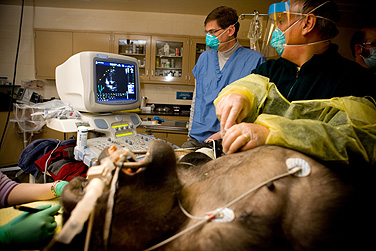News
Faculty member conducts gorilla’s EKG

Sonographer John Gon moves the probe around the gorilla's chest while James Fallavollita watches the monitor. Photo: DOUGLAS LEVERE
-
 Print
Print -
 Comments
Comments
-
Multimedia


Slideshow: Gorilla EKG at the Buffalo Zoo | View slideshow
James Fallavollita, professor of medicine and cardiologist, has performed echocardiograms on humans, mice, rats, hamsters, pigs, dogs, sheep and a cat. When the opportunity arose to work with a different species, he couldn’t pass it up.
“I’m not uncomfortable with taking the machine to an animal I have never seen before and doing a procedure,” says Fallavollita, who, with the assistance of local sonographer John Gon, conducted an “echo” at the Buffalo Zoo last week on Kwizera, a 200-plus-pound female gorilla receiving a physical examination before heading to the Memphis Zoo for breeding. “I was kind of intrigued by the idea of adding another animal to my repertoire.”
Last week’s echocardiogram actually was the sixth Fallavollita had completed on a gorilla. He performed one last year on Kwizera with the help of Thomas Cimato, a fellow medicine department faculty member and cardiologist, and did four more this summer on the zoo’s four other gorillas—three females and a male. The procedure, which involves using sound waves to produce moving images of the heart inside the chest, enables doctors to assess everything from the thickness of the heart muscle to the health of valves that regulate the flow of blood through the organ’s four chambers.
Beyond helping to provide a picture of Kwizera’s general health before she goes to Tennessee, the results of her most recent “echo” also will contribute to increasing understanding of her species.
The information Fallavollita and Gon gathered during last week’s procedure will be entered into a national database of the Gorilla Health Project, which was established a few years ago following the sudden death of several zoo gorillas around the country due to heart ailments. A major goal of the effort is to compile data that can help researchers and veterinarians gain knowledge about heart diseases in the species.
“What causes gorillas to develop these conditions? Is it stress-related? Is it related to blood pressure? And what exactly is going on?” Fallavollita says. “The database they have instituted will help provide baseline measurements for what a normal—and abnormal—‘echo’ is for a gorilla.”
Stefan Ruhl, a faculty member in the Department of Oral Biology, School of Dental Medicine, also was present at the zoo on Dec. 1, obtaining saliva, blood and dental plaque samples from the gorilla. The specimens will help advance his research into human evolution—into how the types of bacteria living inside the oral cavity of primates differ from the types living inside humans, and why.
Before undergoing the echocardiogram and a battery of other tests last week, Kwizera, 21, known to keepers and veterinarians as “Bumpy,” received anesthesia to immobilize her. (She would pose a danger if she were awake,” Kurt Volle, the zoo’s veterinarian, explained. “Gorillas are extremely strong and they can do damage even without meaning to.”)
Personnel transported her, in a cargo net inside a van, from her habitat to a veterinary hospital on zoo grounds, where she received a battery of tests. Once there, she was wheeled in on a gurney, where she lay, belly up, as Fallavollita and Gon examined her using an ultrasound probe.
Fallavollita sets the scene: “We’re in the hospital exam room, and multiple things are going on at the same time. When it is our turn, John just takes the probe, which is shaped somewhat like an ice cream cone, puts some acoustic gel on it, and moves it around her chest. He and I are looking at the images while they’re obtained and discussing how to maximize the quality of the pictures. We’re all within two feet of the animal, but it’s only this probe that touches her.”
The zoo needed Fallavollita’s help, in part, because he had access to an echocardiogram machine capable of harmonic imaging, a technique that increases the clarity of the pictures technicians are able to take. The apparatus Fallavollita used during Kwizera’s examination is one he typically employs on pigs. Part of his research involves studying the way the animals are affected by chronic myocardial ischemia, a heart condition that affects humans, too.
He says he has learned a lot from looking inside the chests of various creatures. What strikes him most is what he calls the “frightening similarity” between the human heart and those of other mammals.
“Surprisingly, the pictures look just like a human,” he says of images from gorilla echocardiograms. “What I’ve threatened to do to my colleagues is to throw up the picture and say, ‘What is this?’ They’d say a normal human heart. The heart is positioned a little bit differently in the chest, but the images that we got are very, very comparable to a lot of the images we get in humans.”

Reader Comments